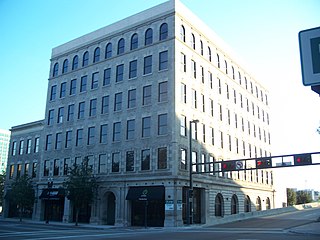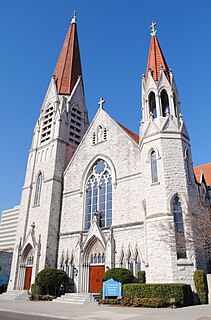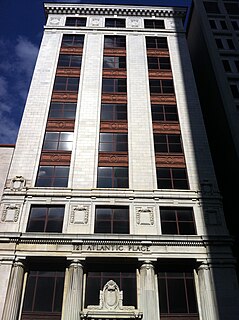Mayport is a small community located between Naval Station Mayport and the St. Johns River in Jacksonville, Florida. It is part of the Jacksonville Beaches communities. The only public road to Mayport is State Road A1A, which crosses the St. Johns River Ferry to Fort George Island.

The Great Fire of 1901 was a conflagration that occurred in Jacksonville, Florida on Friday, May 3, 1901. It was one of the worst disasters in Florida history and the third largest urban fire in the U.S., next to the Great Chicago Fire, and the 1906 San Francisco fire.

Bank of America Tower is a skyscraper in the downtown area of Jacksonville, Florida, at the northwest corner of Bay and Laura streets. At 617 ft (188 m), it is the tallest building in Jacksonville, and the seventeenth-tallest in Florida. It was built as the headquarters of Barnett Bank and originally named Barnett Center, but the name was changed to NationsBank Tower in 1998 after Barnett Bank was acquired by NationsBank. NationsBank soon acquired Bank of America and the building's name was changed to Bank of America Tower in 1999. The 42-floor structure was designed by German-American architect Helmut Jahn, and is constructed of reinforced concrete.

The Dyal–Upchurch Building is a six-story, 43,747-square-foot historic building in Jacksonville, Florida. It is located at 4 East Bay Street, and was designed by architect Henry John Klutho. On April 17, 1980, it was added to the U.S. National Register of Historic Places.

The Schultz Building, formerly the Atlantic National Bank Annex, is a historic building in Jacksonville, Florida, United States. It was built between 1925 and 1926 for the Atlantic National Bank as an annex to the Atlantic National Bank Building, located immediately behind it. It stands at 118 West Adams Street, and was added to the U.S. National Register of Historic Places in 1997 as part of the Downtown Jacksonville Multiple Property Submission.

The Carling, formerly known as the Carling Hotel and Hotel Roosevelt, is a historic building in Jacksonville, Florida, United States built in 1925. It is located at 31 West Adams Street in Downtown Jacksonville. As its former names indicates it was originally a hotel, and was used for that purpose until 1964; it currently serves as a residential building.

The St. James Building is an historic building in Downtown Jacksonville, Florida, currently housing Jacksonville City Hall. It was designed by architect Henry John Klutho and opened in 1912. One of many structures in downtown Jacksonville designed by Klutho after the Great Fire of 1901, it is considered his Prairie School masterpiece.

Henry John Klutho (1873–1964) was an American architect known for his work in the "Prairie School" style. He helped in the reconstruction of Jacksonville, Florida after the Great Fire of 1901—the largest-ever urban fire in the Southeast—by designing many of the new buildings built after the disaster. This period lasted until the beginning of World War I. Several Jacksonville architects began their careers in the offices of Klutho's firm.

The Basilica of the Immaculate Conception is a historic Catholic church in Downtown Jacksonville, Florida, U.S. A parish church in the Diocese of St. Augustine, it represents Jacksonville's oldest Catholic congregation. The current building, dating to 1910, was added to the U.S. National Register of Historic Places in 1992 as the Church of the Immaculate Conception, and was named a minor basilica in 2013. It is located at 121 East Duval Street; its current pastor is Very Reverend Blair Gaynes.

11 East Forsyth, formerly known as the Lynch Building and the American Heritage Life Building, is a historic structure in Jacksonville, Florida. Originally developed by Stephen Andrew Lynch, as its current name suggests, it is located at 11 East Forsyth Street in Downtown Jacksonville. On December 23, 2003, it was added to the U.S. National Register of Historic Places.

The Karpeles Manuscript Library Museum is a museum in Jacksonville, Florida, one of fifteen Karpeles Manuscript Library Museums in the United States, all housed in repurposed old buildings. Other locations of Karpeles Museums include Buffalo, NY; Charleston, SC; Duluth, MI; Newburgh, NY; Santa Barbara, CA; Tacoma, WA; Shreveport, LA; Fort Wayne, IN; Alvin, TX; Rock Island, IL; St. Louis, MO; Gloversville, NY; Pittsburgh, PA; and Great Falls, MT. Karpeles Manuscript Library Museums display manuscripts and documents from the private collection of David and Marsha Karpeles, the world's largest such collection, as well as art exhibits.

The Barnett is a skyscraper in the downtown area of Jacksonville, Florida, at the southwest corner of Adams and Laura streets.

121 Atlantic Place, formerly the Atlantic National Bank Building, is a historic skyscraper in Jacksonville, Florida. It was built in 1909 as the headquarters for the Atlantic National Bank, and is located at 121 West Forsyth Street. It was the tallest building in Jacksonville and in Florida from 1909 to 1912, and remains an office building today.

The Florida Yacht Club is a private country and yacht club in Jacksonville, Florida, U.S. It is the oldest social club in Jacksonville, and is the fourth oldest surviving yacht club in the U.S. It was founded in downtown Jacksonville in 1876 , and moved to its present location in the Ortega neighborhood in 1928.
Mowbray and Uffinger comprised an architectural partnership in New York City formed in 1895. Known for bank buildings and as vault engineers they designed over 400 banks in the pre-World War II era throughout the country. The principals were Louis Montayne Mowbray (1867-1921) and Justin Maximo Uffinger Sr. (1871-1948).

The Atlantic National Bank was an American bank based in Jacksonville, Florida. It existed from 1903 until 1985, when it merged with First Union The company constructed two significant buildings in Downtown Jacksonville: 121 Atlantic Place and the Schultz Building.

Riverside and Avondale are two adjacent and closely associated neighborhoods, alternatively considered one continuous neighborhood, of Jacksonville, Florida. The area is primarily residential, but includes some commercial districts, including Five Points, the King Street District, and the Shoppes of Avondale.

The architecture of Jacksonville is a combination of historic and modern styles reflecting the city's early position as a regional center of business. According to the National Trust for Historic Preservation, there are more buildings built before 1967 in Jacksonville than any other city in Florida, but it is also important to note that few structures in the city center predate the Great Fire of 1901. Numerous buildings in the city have held state height records, dating as far back as 1902, and last holding a record in 1981.

Laura Street is a north–south street in Jacksonville, Florida, United States, named for the daughter of the city's founder, Isaiah D. Hart. Historically, the downtown portion of Laura Street has been considered the financial district of Jacksonville.
Jacob Elias Cohen was an American businessman who served as president and CEO of Cohen Brothers department store in Jacksonville, Florida. He was nicknamed "Wanamaker of the South" after John Wanamaker the proprietor of Wanamaker's department store.
























